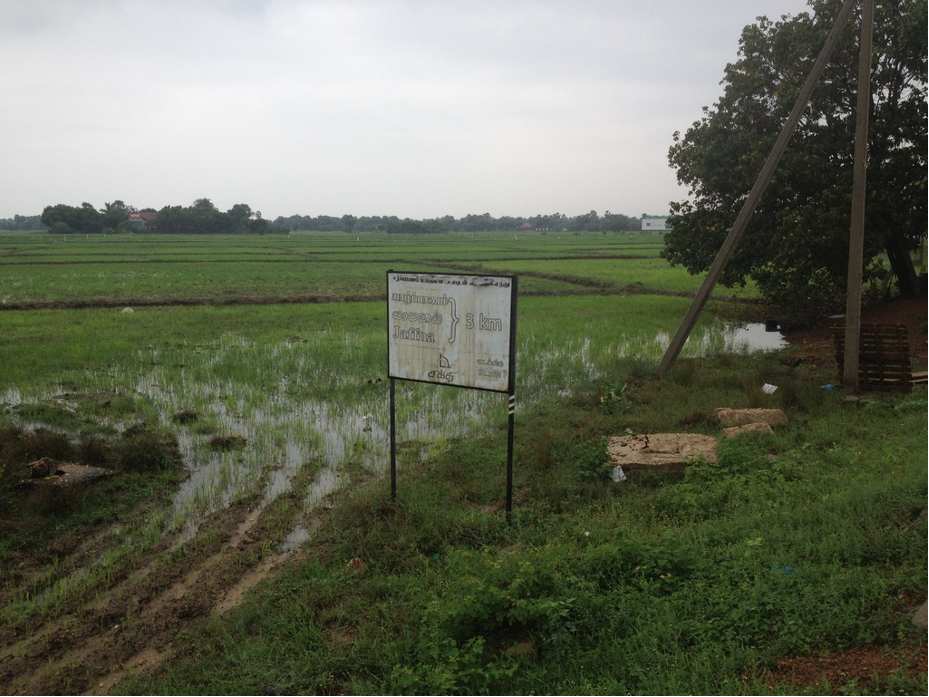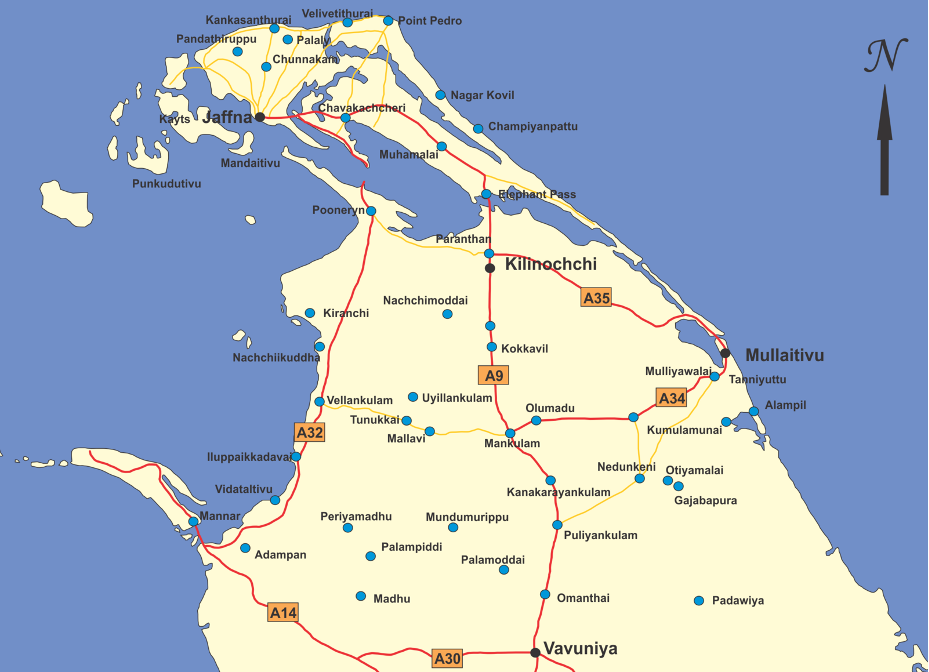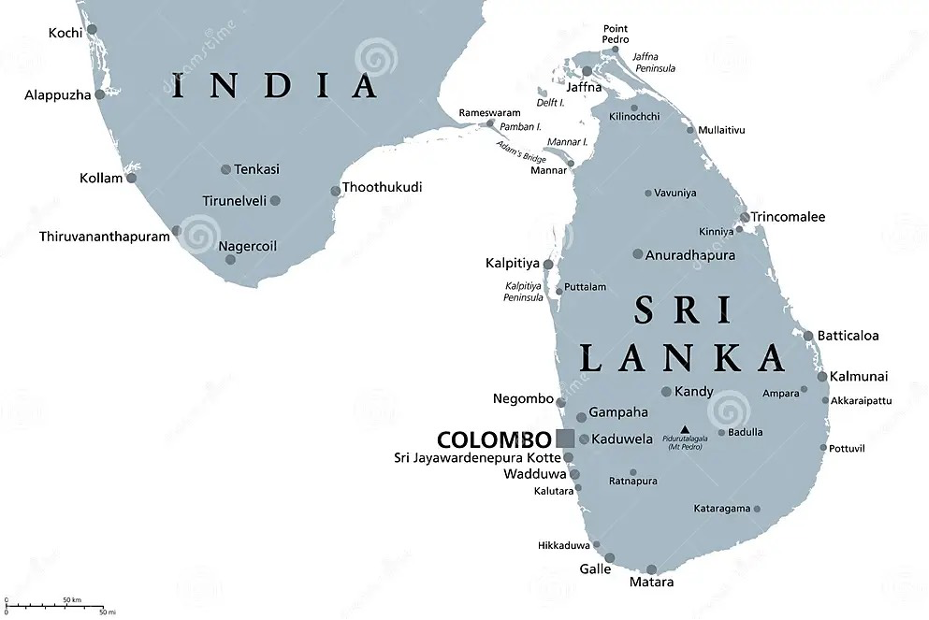Letter from the Sri Lankan killing fields
Some 100,000 lives were lost in the civil war, but justice remains elusive.
I landed in Colombo, the capital of Sri Lanka, just after sunrise, and moved in a trance through the scrum of immigration, customs, money-changing, and finding the bus into town, which dropped me in the center of a market where the road gave way to fruit stalls.
That night, I wanted to ride in a sleeper on the Night Mail train to Jaffna, the small city on the north coast where, in the last stand of the civil war (it ran from 1983 to 2009), the Tamil Tigers together with their families were slaughtered on the beaches.
Despite online assurances that I would have “no trouble” buying an overnight train ticket at Colombo Fort, the main railroad station in Sri Lanka’s capital Colombo, all the railway clerks told me the same thing the morning I arrived: Not only did the Night Mail not have any sleeper cars but all the tickets were sold. One clerk suggested I come back in the afternoon to see if any space had opened up, but he wasn’t hopeful.
Crowds swarmed the station plaza. As I walked through market stalls in the blistering heat, it seemed that monsoon rains might still be on the horizon.
Everything about Colombo—the colonial architecture, tuk-tuks in the street and crowded sidewalks cracked with neglect—reminded me of India, although the Singhalese of the Sri Lankan south are Buddhist, while the Tamils, in the northern half of the country, tend to be Hindu.

Unsure how I would make the trip north, I cased the station until I came upon a sign for the general manager. It was printed in a typeface that seemed to date to the era of British rule. Independence for Ceylon—as the island was called then—came in 1948, and when it became a republic within the Commonwealth in 1972, it changed its name to Sri Lanka.
I pushed open the door and found a harried station manager in his gloomy office, doing his best to run the trains on time. It didn’t seem appropriate to ask him for a ticket on the night train, so I explained that I had written books about the rails and was looking for a map of the Sri Lankan railroad network. With it, I might figure out another way north—for example, through the colonial port of Trincomalee.
The station manager warmed to our railway conversation. Soon he asked me to sit beside his desk, where one of his staff served us tea. When he asked why I was in Colombo, I explained about trying to get a seat on the night train to Jaffna.
The manager explained that because it was a Friday afternoon, many trains were full. “But don’t worry,” he said. “I am allotted a seat on every train that leaves Colombo. You can take mine. I shall be here.”
With a few phone calls, he arranged for me to have his seat on the Night Mail, saying that it would leave at 8:30 p.m. and arrive the next morning at 6 a.m.
Later, in the confines of the First Class Waiting Room, I studied an old map that showed a rail line snaking north both to Jaffna and the end game of the brutal civil war.
The overnight trip felt like a ten-hour subway ride. Although the coach was air conditioned, the suspension on the car was worn, and we bucked and rolled through the darkness. I woke up every few hours with the sensation of traveling on a roller coaster. All the seats in the car were taken, but because it was first class, the passengers kept to themselves. Jaffna was the end of the line.
The Sri Lankan civil war is among the longest of the modern era—up there with those in Lebanon and Vietnam. In brief, the Tamils fought to secure independence for the northern half of the country, and the ruling majority Singhalese resisted. Some 100,000 lives were lost during the fighting, which ended in 2009 with the massacre of the Tigers in an enclave near Mullaitivu. At home in Switzerland, I had listened nightly to BBC broadcasts about the war’s end, when the Sri Lankan army rounded up both soldiers and civilians in this deadly pocket, and it was to fill in the images of that beachside siege that I had come to Jaffna and northern Sri Lanka.
Belfast by the sea
The Liberation Tigers of Tamil Eelam, also known as LTTE or the Tamil Tigers, had wanted to create a Hindu country to be known as Tamil Eelam, with the dividing line running across the island through the town of Vavuniya, and wrapping around each coast (imagine the letter A imposed on northern Sri Lanka).
The fighting was brutal. The Tamils can claim credit for having invented (in the modern era, anyway) suicide bombing, and during the conflict they sent Tamil grievances south to Colombo with a series of terrorist blasts.
In response, the army imposed a state of siege across the north of the country, with attendant roadblocks plus repression and torture. For years, if it ran at all, the Night Mail traveled no further north than Vavuniya, which during my restless night on the train I had seen in the guise of a darkened rail platform that might have been painted by Edward Hopper.
Although Jaffna is the principal city in northern Sri Lanka, and would have been the capital had independence come to Tamil Eelam, it seemed more a jungle town. Rain dripped off palm leaves and the drivers of small scooters. I found a small guest house near the station, in which I could shower and eat breakfast.
My taxi driver showed up after breakfast. Underway, we passed a short row of shops and houses, and at times he would stop in front of a library or a church, all of which had been torched during the civil war.
At one point, he motioned for me to look at a haunting Buddhist temple that only recently had reopened. I might well have been near to Joseph Conrad’s heart of darkness, except that the platoons of Sri Lankan soldiers I saw on patrol gave Jaffna the air of Belfast.
The patrolling soldiers wore green berets and carried automatic weapons—one reason, I assume, why the nearby beaches were empty. We drove along the misty Beach Road and saw the ports (little more than docks) where early in the war, the Tamils had brought guns from India.
Moving southeast, the driver stopped along the Chemmani Road so I could take pictures of a forlorn stretch of marshland. Here, toward the end of the civil war, the mass graves of 300-400 Tamil rebels and civilians were discovered in land that much of the year is underwater. I struggled in the driving rain to take a clear picture of the swamp and to fathom what had driven the Sri Lanka army to murder so many women and children during the conflict.
Later, when I was home, I read Gordon Weiss’s The Cage: The Fight for Sri Lanka and the Last Days of the Tamil Tigers, a sober history in which he describes how both sides gave little quarter in the fighting. He writes that throughout the war, “the Tigers dispatched 273 suicide attackers on 137 missions,” killing some 4,100 civilians.
In response, the army turned the northern part of the country into a battleground, in which the Tamils were hunted down. Weiss describes the endgame in early 2009: a 16-week siege in which roughly 160,000 Sri Lankan soldiers “faced off against 2,000 to 5,000 Tigers, seeded amid a civilian population of some 330,000, resulting in between 10,000 to 40,000 deaths.”
At the same time, Sinhalese policemen burned Jaffna’s historic library and irreplaceable archives and rare manuscripts. Many Tamils regard the act as “cultural genocide,” Weiss writes, the erasure of their history in Sri Lanka. When we drove past the restored library, I could see small clusters of Tamils standing in front of its iron gate—a mournful vigil as an act of silent rebellion.
The Indian Army tried to intervene in the conflict from 1989 to 1990 with a peacekeeping force that failed miserably to impose a settlement on the combatants. One reason the war finally ended (admittedly only in 2009) was that India withdrew its support from the Tamils, at least at a governmental level, after a Tamil suicide bomber in 1991 assassinated Prime Minister Rajiv Gandhi.
Elephant Pass to a cage of war
Further down the coastal road, in the town of Elephant Pass, we stopped at a war memorial to see where the Sri Lankan army made a desperate stand against a Tamil attack. The pass is the narrow neck of land between the Sri Lankan mainland and the Jaffna peninsula.
On either side of the two-lane road are sand dunes and bogs, which explains why battles were fought for almost 30 years for the control of this stretch of the highway. Weiss writes: “In 2000, Tamil Tiger forces had finally seized the fortress. Now the positions were about to be reversed. [Sri Lankan commander] Gotabaya’s army was poised to break the Tiger defenses in the northern corner of the triangle.”
In one of the pivotal encounters of the war, a Sri Lankan corporal named Gamini Kularatne mounted a nearby construction tractor and used the raised plow to fend off Tamils in what turned out to be a suicide mission (for both sides). His last act, and his tractor, are now remembered with a Singhalese war memorial made from fragmented iron.
I wanted to see the remainder of the so-called “triangle,” where the civil war ended, but the driver explained that I could easily and cheaply take the public bus to Puthukkudiyiruppu and Mullaittivu, between which the Tamil resistance had been crushed.
He dropped me at the bus station in Kilinochchi—once a rebel stronghold, with a fallen water tower to commemorate the fighting—and put me on a bus for Puthukkudiyiruppu, where the violent end of the war was played out in another coastal swamp.
The route ran through the heartland of the Tamil pocket, from which Weiss took the title of his book, calling it “the Cage.” Every so often, there were clusters of houses, although it would be an exaggeration to call those settlements villages. In 2009, civilians uprooted by the fighting amassed along this road, seeking shelter and humanitarian aid. Weiss asks, “Had the entire Tamil civilian population trapped between the two forces become a legitimate potential target?”
Off in the jungle, to the south of the road, was the bunker complex that housed the Tiger leadership. Its members lived underground, but some had upholstered furniture, a swimming pool and air conditioning, while dissidents to Tamil rule were housed back on the main road, in a makeshift prison the driver said was now on an army base.
In many respects, the Tamils in the Cage were prisoners of war. As the Tigers’ end approached, they refused to let their civilian compatriots flee, in effect turning their supporters into hostages for the rebel cause. To match this inhumanity, the Sri Lankan army shelled even the local hospital, claiming that the Tamil leadership was hiding warriors in its basement.
After the war, the government built some 147 new army bases and police stations in the north. Along the road, army life could be seen behind stockades of barbed wire. There were parade grounds, barracks and cricket fields, but the bases also spoke of repression being just a quick phone call away.
After about an hour, I got off the bus near the town of Puthukkudiyiruppu, near where the Tamils made their last stand. Weiss writes:
The Tigers had been steadily building this eastern coastal town, once a center of fishing in the region, into both a formidable stronghold in its own right and one of the main bases from which the Sea Tigers regularly launched suicidal attacks on Sri Lankan naval ships.
Today the town is given over to local markets and shops.
Just outside the town center, at the end of a boardwalk, I found a war memorial rising out of the marshland. In this bleak swamp, the army surrounded the remnants of the Tiger leadership and killed them to a man.
Now all that remains is a small shrine with burned candles scattered about the base. Here the Cage turned into a noose. The Tigers decided to go down fighting, and the Sri Lankan army herded them into these wetlands from which there was no escape, especially from the artillery.
Weiss describes the immediate aftermath of the fighting:
Empty of people and corpses, the landscape below revealed a confetti of shredded plastic sheeting across a vast sandy expanse of bomb craters, fire-blackened smudges, lines of earthen bunds, knots of hasty graves, smashed houses, burned-out vehicles, broken coconut trees, gun emplacement positions, trenches and the detritus of human habitation.
The presence of civilians trapped in the same coffin corner at the war’s end is one reason why many on the UN Human Rights Council wanted to persecute the army and some of its political masters for war crimes.
Thousands of civilians were caught up in the civil war’s endgame, and many were killed or wounded when the army first proclaimed a no-fire zone around Puthukkudiyiruppu but then ignored its own ban and bombed the Tamils and the fleeing population indiscriminately.
The vise tightens on the beach
From the wetland monument, I rode another bus south and walked to a bizarre open-air museum. I went down a dirt path leading to the beach, where the Tamils had put together a makeshift fleet to resupply their besieged lines and carry out more suicidal attacks.
Now the small shipyard is a war museum with rusting hulks piled up on the sand dunes. Arriving in the midday heat, I discovered the skeletal remains of submarine warfare and a solitary solider who greeted me and sold me a warm orange soda. He encouraged me to look around at the captured wrecks.
The exhibit emphasizes that the Tamils lived on stealth connections with mother India and were training, when the war ended, to extend the fight under the waves, with a fleet of suicide submarines, the equivalent of underwater kamikaze.
From the beachside war museum, I caught a ride to the nearby town of Mullaitivu. Again, I noticed a strong army presence around the town, and when I went to take a picture of a roadside memorial, a young soldier approached me, happy that someone had come a long way to appreciate the sacrifices of his fellow servicemen.
He walked me around to some other markers and pointed to the bus that would take me to Vavuniya, which once marked the southern border of the breakaway Tamil enclave. It took two hours for that bus to cut southwest through more landscape the civil war had defiled but which now appeared simply as neglected farmland.
When I got home to Geneva, wanting to know more about what happened after the war, I got in touch with officials who hope to prosecute some of those responsible for the slaughter. In particular, I spoke with an international human rights lawyer named Richard Rogers, who is now the Secretary and a Member of the Sri Lanka Monitoring and Accountability Panel. He said that only after the government changed in 2015 was it possible even to consider steps toward bringing those who had killed civilians to justice, especially during the last days of the war in the landscape I saw around Puthukkudiyiruppu and Mullaittivu.
In an ideal world, Rogers said, senior military officers and government officials would be tried before the International Criminal Court in the Hague. But he did not see that happening, especially since neither the United States nor its allies wanted to apply pressure on Sri Lanka only to see it move closer to China’s orbit. He mentioned the possibility of Sri Lanka’s setting up a truth and reconciliation commission, along the lines of what was done in South Africa after apartheid. But Rogers implied that great power politics had allowed the government to sidestep such an inquiry.
In a published interview, he said, “I think there have been no practical steps taken by the government that can bring redress to the victims of the war. Not only that, but there have been further human rights abuses committed by government actors.” To that he added, “The crimes committed in Sri Lanka were certainly some of the worst this century. There were more than 40,000 people killed just in the last two years of the war and hundreds of thousands of people displaced.” But then everyone from Winston Churchill to the bestselling author Dan Brown has made the point that history is written by the winners.
Matthew Stevenson is the author of many books, including Reading the Rails; Appalachia Spring; The Revolution as a Dinner Party (China throughout its turbulent twentieth century); Biking with Bismarck (France during the Franco-Prussian War); and Our Man in Iran. Out not long ago were: Donald Trump’s Circus Maximus and Joe Biden’s Excellent Adventure, about the 2016 and 2020 elections, and The View From Churchill, about the places that shaped the life of the British wartime prime minister.






Thanks for this Matthew. Chilling stuff.